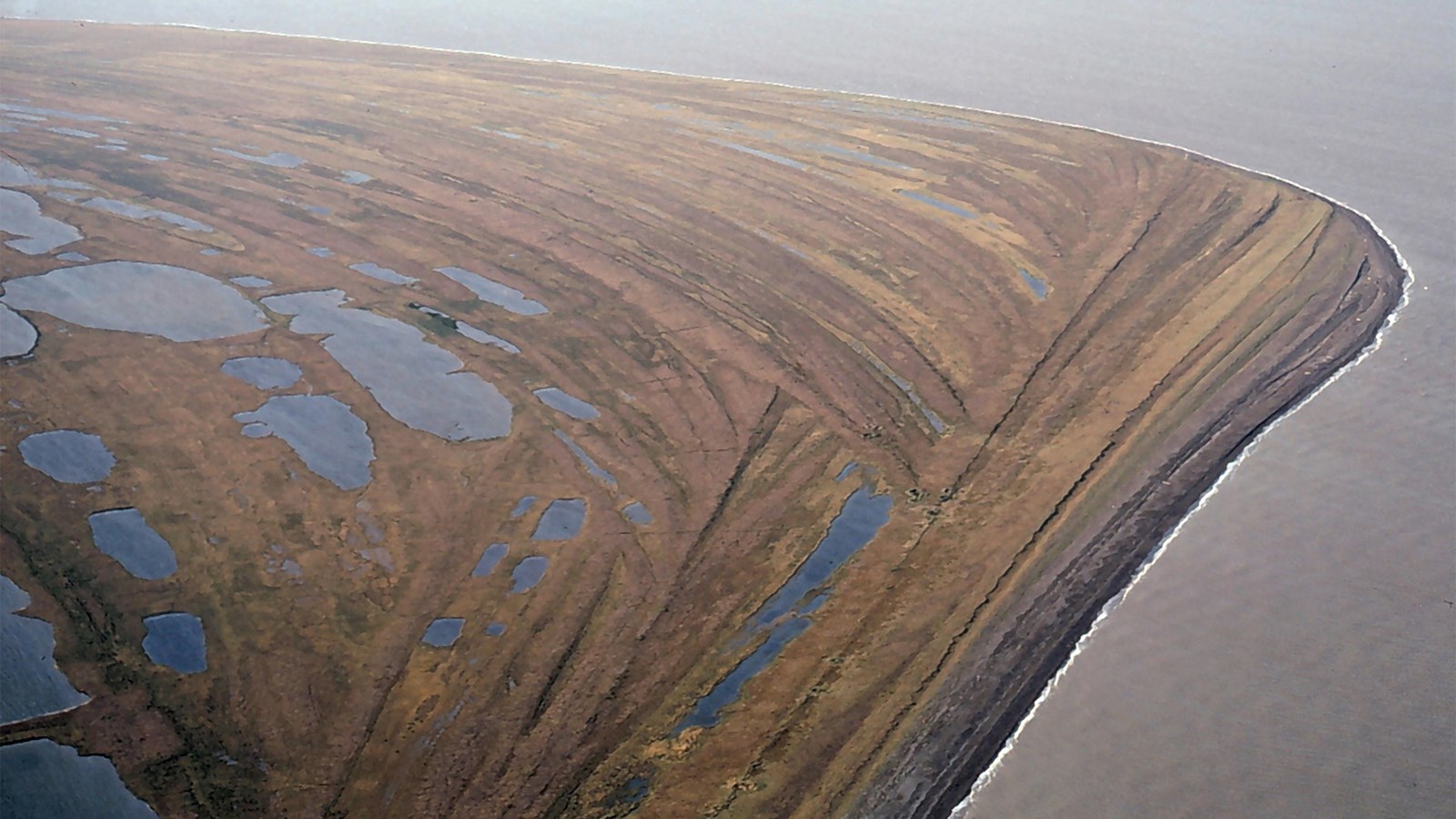Last updated: May 8, 2020
Place
Cape Krusenstern National Historic Landmark

NPS Photo
Land and Sea
The Cape Krusenstern Archeological District National Historic Landmark is an impressive combination of ancient coastal villages and upland villages. The landmark highlights the archeological and contemporary importance of travel, trade, communication, and hunting and gathering between the coast and the western foothills of the Brooks Range. This sizable landmark may seem haphazard to outsiders, but to northwestern Alaskans the area is an entirely connected landscape that has provided for them and their ancestors throughout the cycle of seasons for countless generations.
So far, archeologists have focused most of their attention on the coastal archeological sites that were settled as early as 5,000 years ago. All along the coast, archeologist have identified several archeological tool traditions that indicate either differing cultural groups or different activities. From these clues we can learn how people have connected to the land and with each other.
A Mysterious Series of Archeological Traditions
Archeologists call the earliest known archeological tool tradition at Cape Krusenstern, Denbigh. During this time at Cape Krusenstern, from around 2000 BC to 750 BC people mostly moved around to seasonal camps. During spring and summer they hunted seals on the coast. Little is known about inland activities during other seasons. At inland sites next to rivers and lakes, archeologists have found semi-subterranean house remains from this time period, which were most likely winter homes. Archeologists see this as a period when maritime hunting and fishing came into focus over solely depending on inland resources, like caribou and other land animals.
Choris is the next grouping of tool traditions. At Cape Krusenstern, the Choris tradition was practiced between 750 BC and 250 BC. The remains of temporary Choris camps are found at Cape Krusenstern’s coasts. This technological period saw the highly significant advent of pottery vessels. Winter camps from this period have been found inland, like at the Onion Portage National Historic Landmark in the Kobuk River valley. And like at Onion Portage, at Cape Krusenstern’s archeological sites, there’s an interval of several hundred years between the Denbigh tradition and Choris tradition, where there seemed to be no people living in the area. Despite the gap in occupation and distinctive tool technologies, people of the Choris tradition relied on the same inland or coastal resources. Archeologists believe some groups took to living on the coast through all or most of the year, while other groups stayed inland through most of the year. Cultural distinctions between inland and coastal dwellers were more distinct from than they had been during the previous tool tradition.
A unique settlement from this period is found at Cape Krusenstern. They’re called the Old Whaling culture by archeologists and they lived on the Cape Krusenstern coast, building two different house styles for winter and summer. Various whaling tools, like special harpoons and butchering tools, are found at the site, but animal remains don’t indicate that whales were the main resource extracted there. The origins and cultural connections of the Old Whaling settlement at Cape Krusenstern remain a mystery.
The Norton archeological tool tradition, spanning between 250 BC and 650 AD, came from the previous Choris technology, including using pottery. Animal bones and specialized tools from archeological sites of this time period show people stepped up their sea mammal hunting industries.
From 250 AD to 850 AD, the Ipiutak archeological tool tradition defines what’s known of this period. The population seems to have grown during this period, and artifacts show differing social statuses have developed, particularly in burial assemblages. Instead of whaling, people targeted caribou, seals, and walrus. At Cape Krusenstern, archeologists study a variety of structure types that people built on the coast during this time. Radiocarbon dates and the arrangements of the structures suggest that there were at least five different settlements using the beach ridge plain on the southern coast of the National Historic Landmark during the Ipiutak period. Archeologists are continuing their research to understand what seasons and purposes the Cape Krusenstern coast served at that time.
The Ancestors of Iñupiat Traditions
The Birnirk archaeological tool tradition (from 650 AD to 1250 AD) followed in the footsteps of Ipiutak in northwestern Alaska. One Birnirk settlement has been studied at Cape Krusenstern that includes an intriguing addition of Ipiutak characteristics. Others archeological tool traditions emerge during this time period in northwestern Alaska, such as Thule, Punuk, Old Bering Sea, and Okvik. Archeologists are still working out the relationships between the simultaneous tool technologies in the region. It has been demonstrated that these groups are the ancestors of modern Iñupiat.
The archeological record is quite clear that by 1250 AD, people of northwestern Alaska have branched into distinct coastal or inland cultural groups. Archeologists consider inland technologies to be the Arctic Woodland period. Coastal technologies from this time are called the Kotzebue period. At Cape Krusenstern, Kotzebue period archeological sites are quite common. Large whaling villages still thrived at Utqiagvik (Barrow) and Tikigaq (Point Hope), but at Cape Krusenstern, folks lived in smaller groups and directed their energy to fish, seals, and caribou.
Still Here
When encounters with Russian explorers around 1750 AD began to occur, the Alaska Native population drastically decreased. They adapted to the changes in their communities and economy. There are two villages within the Cape Krusenstern Archeological District National Historic Landmark. Kivalina, on a coastal lagoon, and Noatak, on an inland river bank. During the summer, Alaska Natives from Kotzebue and other surrounding villages continue seasonal summer residence on the Cape Krusenstern coast, hunting, fishing, and gathering for their families.
Additional Information
Cape Krusenstern National Monument
Cape Krusenstern archaeology project wins national award, Anchorage Daily News, 2015
